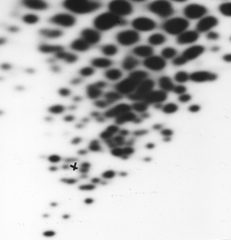
Origin of current influenza H1N1 virus
 Influenza viruses of two subtypes, H1N1 and H3N2, have been causing respiratory infections in humans since 1977. Before that year, it was believed that only one human subtype circulated each flu season. How did this unusual situation come about?
Influenza viruses of two subtypes, H1N1 and H3N2, have been causing respiratory infections in humans since 1977. Before that year, it was believed that only one human subtype circulated each flu season. How did this unusual situation come about?
Major changes in the surface glycoproteins of influenza virus – called antigenic shift – lead to worldwide epidemics of influenza known as pandemics. There have been six instances of antigenic shift since 1889. In that year, H2N2 viruses circulated, followed by H3N8 in 1900, H1N1 in 1918, H2N2 in 1957, H3N2 in 1968, and H1N1 in 1977. Each pandemic strain carries HA and NA proteins that have been absent in humans for many years, and therefore immunity is either very low or nonexistent.
Influenza viruses of the H3N2 subtype were still circulating in humans in May of 1977 when H1N1 viruses were isolated in China and then Russia. In the winter of 1977-78 the H1N1 viruses caused epidemic infection throughout the Northern Hemisphere. The results of serological tests indicated that the HA and NA glycoproteins of the 1977 H1N1 viruses were very similar to those from viruses of the same subtype which circulated in 1950. Palese’s group compared viral RNA of one 1977 isolate, A/USSR/90/77, with RNA from a virus isolated in 1950. To their surprise, the two viral RNAs were highly related. In contrast, there was less similarity between viral RNAs from the 1977 H1N1 virus and H1N1 viruses that circulated in humans between 1947 and 1956.
Why were the viral genomes of the 1977 H1N1 isolate and the 1950 virus so similar? If the H1N1 viruses had been replicating in an animal host for 27 years, far more genetic differences would have been identified. The authors suggested several possibilities, but only one is compelling:
…it is possible that the 1950 H1N1 influenza virus was truly frozen in nature or elsewhere and that such a strain was only recently introduced into man.
The suggestion is clear: the virus was frozen in a laboratory freezer since 1950, and was released, either by intent or accident, in 1977. This possibility has been denied by Chinese and Russian scientists, but remains to this day the only scientifically plausible explanation.
The close genetic identity between the 1950 and 1977 H1N1 strains was revealed by oligonucleotide mapping. In this technique, purified viral RNA is cleaved with an enzyme, RNAse T1, that cuts the RNA after every G base. The oligonucleotides are labeled at the 5′-end with 32P, separated by two-dimensional gel electrophoresis, and detected by exposing the gel to X-ray film. The oligonucleotides form a pattern (‘fingerprint’, pictured) that can reveal genetic differences between virus isolates. This technique is more sensitive than serologic assays, but only provides information on about 10-15% of the viral RNA. However, the larger oligonucleotides are a representative sample of the entire genome. The authors calculated that there was a minimum of 8 bases changes among the large oligonucleotides of the RNAs of the 1950 and 1977 H1N1 viruses. In contrast, the RNA of the 1977 H1N1 isolate had 38 base changes compared with a 1947 H1N1 isolate.
Oligonucleotide mapping was used to study the genome of the 1977 H1N1 viruses because nucleotide sequencing was not yet in widespread use. Because nucleotide sequencing is now routine, oligonucleotide mapping is no longer used – as scientists like to say, it has been relegated to the museum of obsolete experimental methods.
I was a Ph.D. student in Peter Palese’s laboratory when Katsuhisa Nakajima and Ulrich Desselberger did the work in 1978 that revealed the close identity of the H1N1 strains with isolates from 1950. It revealed to me, for the first time, how an important finding creates enormous excitement in the laboratory and in the scientific community, and how general interest is fueled by the press. The work was accompanied by a News and Views article entitled “Influenza A viruses: shaking out our shibboleths”. I clearly remember Peter Palese asking me if I knew what a shibboleth was. I thought it was one of H.P. Lovecraft’s fictitious creatures.
Katsuhisa Nakajima, Ulrich Desselberger, Peter Palese (1978). Recent human influenza A (H1N1) viruses are closely related genetically to strains isolated in 1950 Nature, 274 (5669), 334-339 DOI: 10.1038/274334a0
Francis A. Ennis (1978). Influenza A viruses: shaking out our shibboleths Nature, 274 (5669), 309-310 DOI: 10.1038/274309b0
ATTENTION READERS
We See The World From All Sides and Want YOU To Be Fully InformedIn fact, intentional disinformation is a disgraceful scourge in media today. So to assuage any possible errant incorrect information posted herein, we strongly encourage you to seek corroboration from other non-VT sources before forming an educated opinion.
About VT - Policies & Disclosures - Comment Policy



